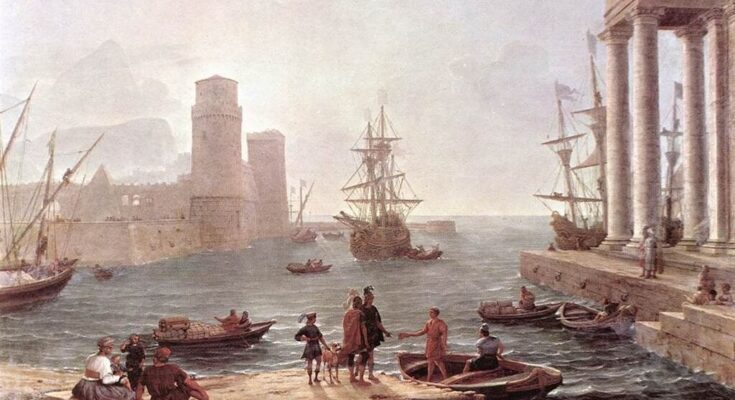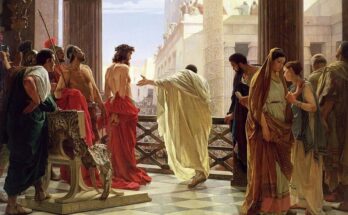
At some point, most of us have encountered novels deemed “classics”—those enduring, timeless works that have been handed down to us through the ages and continue to resonate with readers across generations. They have shaped not only our literature but also who we are and how we see the world. The roots of the classic tradition go back as far as ancient Greece, with Homer’s epic poems The Iliad and The Odyssey and ancient Greek myths in general having defined certain classic novels.
Over the centuries, countless authors have drawn inspiration from ancient Greek mythology to compose their own breakthrough works. Myths of the twelve Gods and other figures such as Odysseus, Hercules, Prometheus, and Eros have triggered the imagination of both classical and modern writers from James Joyce to the controversial Oscar Wilde. Here are a few classic novels rooted in ancient Greek myths that everyone should read at least once in their lifetime.
So what are these five classic novels inspired by Greek myths?
- Ulysses, by James Joyce
James Joyce is considered one of the greatest Irish novelists of all time, and his admiration for Homer’s work runs deep. He particularly admired Odysseus, who he saw as one of literature’s most well-rounded and complex figures. The journey of Odysseus, who spent ten years in peril on his way home to Ithaca after the Trojan War, inspired Joyce’s 1922 novel Ulysses—whose title is the latinized form of Odysseus.
Ulysses unfolds over the course of a single day in Dublin, following the lives of three characters. In a nod to The Odyssey, the novel is structured into episodes, each named after a key moment in Homer’s epic, with titles like “Calypso,” “Lotus Eaters,” “Cyclops,” “Circe,” “Penelope,” and “Ithaca,” amongst others.
Joyce skillfully draws metaphorical parallels between his characters and those from The Odyssey, as well as key events. The protagonist, Leopold Bloom, is a modern version of Odysseus, while his wife, Molly Bloom, reflects Penelope. This picture is completed by Stephen Dedalus, who is a counterpart of Odysseus’ son, Telemachus. As with much of Joyce’s work, Ulysses explores themes of Irish nationalism and the complex relationship with British rule, blending politics with ancient myth. This synthesis makes Joyce’s novel a personal and universal work of art.
- Frankenstein, by Mary Shelley
The full title of Mary Shelley’s 1818 novel, Frankenstein; or, The Modern Prometheus, is no accident. Shelley drew inspiration from the figure of Prometheus in Aeschylus’ Prometheus Bound and Ovid’s Metamorphosis. In Frankenstein, she reimagines this ancient myth through the lens of Victorian Gothic.
Frankenstein centers on Victor Frankenstein, a passionate and coltish young scientist who brings a sapient creature in his laboratory. This groundbreaking act of creating life out of nothing mirrors the myth of Prometheus, who defied the Olympian gods by stealing fire to give to humanity—thus giving them the power to build civilization.
But Shelley’s allusion to the Prometheus myth doesn’t end there. She also mirrors the punishment inflicted on Prometheus in Victor’s fate. In Greek mythology, Zeus condemned Prometheus to eternal torment, chaining him to a rock where an eagle devoured his liver each day, only for it to regenerate overnight.
Likewise, Victor is trapped in a cycle of anguish and guilt, relentlessly pursued by the very creature he brought to life. This parallel between myth and modern tragedy makes Frankenstein one of the greatest works of Gothic literature.

- The Picture of Dorian Gray, by Oscar Wilde
The Picture of Dorian Gray, by Irish author Oscar Wilde, tells the story of a vain, hedonistic young man whose obsession with beauty drives him to sell his soul for eternal youth. His friend, artist Basil Hallward, paints a portrait of Dorian that mysteriously grows older and more corrupted—reflecting his sins—while Dorian himself remains untouched by time.
This idea of vanity might seem familiar: in composing his novel, Wilde drew loose inspiration from the ancient Greek myth of Narcissus. In this myth, Narcissus, a hunter admired for his beauty, rejected all those who sought his love. Ultimately, he became captivated by his own shiny reflection in a pool of water, unaware it was merely an image of himself. Spellbound by his own beauty, Narcissus wasted away gazing at the water and eventually drowned.
Dorian Gray can be viewed as a Victorian-era Narcissus, consumed by his own vanity. His obsession with his portrait at last became his undoing and led to his tragic downfall. The myth of Narcissus that echoes through Wilde’s work feels more relevant than ever today—and this classic certainly holds some valuable lessons.

- Autobiography of Red, by Anne Carson
A more “contemporary” classic, Autobiography of Red is a verse novel published in 1998 by author, essayist, and professor Anne Carson. Its inspiration lies in the myth of Hercules and his Tenth Labor, where he must retrieve cattle from the three-bodied giant Geryon. In Greek mythology, Geryon is depicted as a giant in monstrous form, a grandson of Medusa and nephew of Pegasus.
In her novel, Carson offers a fresh, metaphorical interpretation of the myth. Geryon is portrayed as a “monstrous” young boy who endures abuse from his older brother, finds solace in photography, and kindles a romance with a young man named Herakles.
Carson’s reimagining shows how a writer well-versed in ancient mythology can reshape these stories into something of her own, critical and informed, which resonates powerfully with modern readers.
5. ‘Till We Have Faces, by C.S. Lewis
‘Till We Have Faces is a 1956 novel by C.S. Lewis, author of The Chronicles of Narnia. It draws from two lesser-known figures in Greek mythology: Eros, god of love, and Psyche, goddess of the soul. Lewis specifically reimagines the ancient tale of Cupid (the Roman counterpart of Eros) and Psyche, as told by Apuleius in the 2nd century AD, shifting its perspective.
The novel retells the myth of Cupid and Psyche through the eyes of Psyche’s older sister, Orual. Unlike the ancient myth in which Psyche’s sisters are portrayed as envious of her relationship with Eros, deceiving their sister into betraying him, Lewis gives Orual a compelling voice. She openly accuses the gods and attempts to rescue Psyche, who has been sacrificed to the “God of the Mountain.”
Orual narrates the story as it “truly” happened, challenging the original myth. As such, Lewis shows how a narrative such as his can reshape the meaning of a myth.



